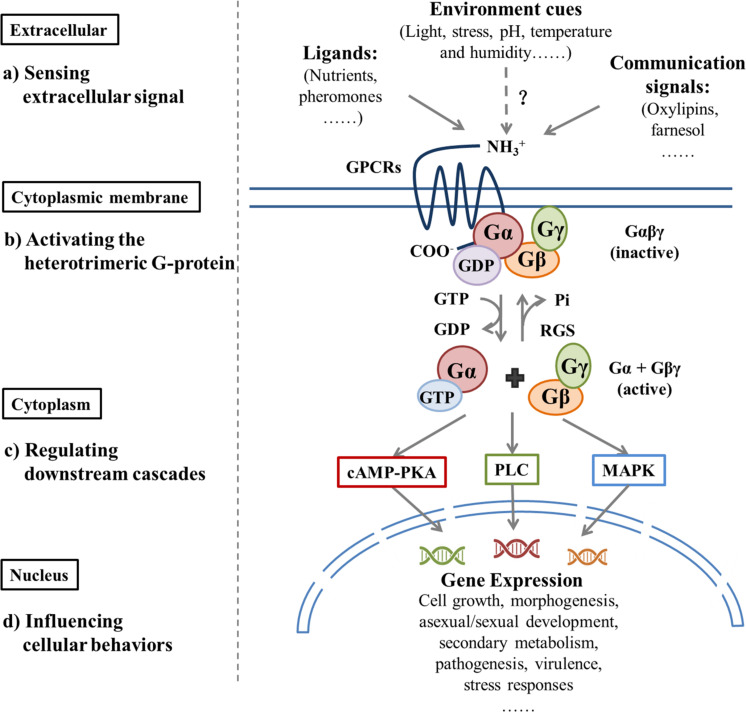New research has revealed how fungi/molds can become lodged in our blood vessels, restricting blood flow as it blocks the blood supply to our brains.
These microbes start corrupting our immune system and biological autonomous processes as they rapidly multiply in what appears to be an attempt to commandeer the central nervous system to control our minds.
Not only can fungi block the blood flow to our brains, but they can also grow in the small blood vessels causing them to stretch, form clots, and explode.
Blood flow is very important when it comes to IQ because research has shown that a lack of blood flow to the brain has been associated with less intelligence and having an adequate amount of blood flow has been proven to increase intelligence.
Altered cerebral blood flow (CBF), which means less blood flow to the brain has been proven to lower IQ and cause severe mental disabilities, psychosis, and chronic schizophrenia (SCZ).
Studies have shown that fungi are extremely polarized organisms that constantly produce internal electrical currents and fields that are generated by hyphae. Its growth requires a constant supply of proteins and lipids to the hyphal tip.
Researchers have proven that the individual hyphae of the filamentous fungi constantly perform cellular “monologue” and cell-to-cell dialog using signal oscillations to acquire or magnetically attract the nutrients it requires to grow and thrive within the host.
For example, studies have found how psilocybin reduces low frequency oscillatory power in users brains, increases overall firing rates and desynchronizes local neural activity. It indicates experiences correlate with the lagged phase synchronization of delta oscillations. Schizophrenia, which mimics symptomatically the psychotic effects of psilocybin, is associated with diffuse delta rhythms.
These oscillations create electricity which is one of the key factors shaping their growth and development. The hyphae become polarized and entrained as the branching of mycelium is induced by electric field frequency, which it uses to communicate and transport the raw human materials within the blood and central nervous system.
The electrical current helps fungi with the translocation of resources it gathers within the host using magnets and hydraulic pressure.
Think of it like a driverless Tesla navigating the U.S. highway and air traffic system but it moves things around autonomously with electrical currents and hydraulic pressure without the need for the driver to consciously pilot the vehicle or aircraft
Researchers have discovered that fungi exhibit “several types of oscillations and characterized families of fast, slow, and very slow oscillations.
These electrical oscillations are very similar to the human brain, where fast oscillations might be related to responses to stimulation, including endogenous stimulation by the release of nutrients, and slow oscillations might be responsible for memory consolidation.”
Scientists believe that the direction of hyphal extension and the frequency of branching and germination could be affected by this electric field. Meaning the electric field’s frequency and power or lack thereof produced in our bodies determines our fates.
As if humans were the self charging batteries and computer programs powering the Matrix we know of as life.
Yes, Neo, it is like that…
The long, filamentous tendrils that these organisms use to penetrate their host’s tissue and blood to gather nutrients and information from their environment or host. All the while within your cells, blood, veins, and organs, it grows within the perfect environment as it procreates, and explores, creating a network of hyphae that turns into a ball-like mass called mycelium.
One that I believe grows as it molds itself within our veins and central nervous system creating – Mold People.
As I have explained in a previous essay, trees actually communicate through a complex network of fungi that connect trees forming a symbiotic relationship. The uncanny resemblance between the human dendrites which are like filamentous structures within the brain and the fungi in the air and within the soil (mycelium).
You will find that these fungal mycelium networks are remarkably similar to the neural and central nervous systems of humans and animals and almost every biological system seems to be a copy of a copy. After all, they all serve the same means.
HOW DO FUNGI MIND CONTROL AND ARE THE BODILY LEGISLATORS OF HUMANS FROM WITHIN
A study that was published in the journal PLoS Pathogens shows how the fungus known as Cryptococcus neoformans infects our blood and then becomes lodged in blood vessels where they live and grow preventing blood flow and increasing blood pressure.
Cryptococcus is found all over the world in soil and it is often in bird excrement. It is the most common fungus that causes thousands of serious infections worldwide. If you breathe the fungus in, it infects your lungs and blood and can spread throughout the body (disseminate).
It is a facultative intracellular pathogen, which means that they are capable of growing and reproducing inside the cells of a host.
Several studies have shown that fungi cross the blood/brain barrier to infect the brain blood vessels as it spreads into the brain causing “fungal meningitis,” which affects an estimated 2.5 million people each year.
Dr. Simon Johnston, from England’s University of Sheffield’s Department of Infection, Immunity and Cardiovascular Disease, said: “The brain has very complex and effective defenses against microbes, but we have identified a simple and effective method that microbes may use to escape the blood and enter the brain.
“Previous research has focused on how microbes can break down the defenses of the brain or use immune cells as a route into the brain. We can demonstrate how, for some microbes, damaging blood vessels is a very effective method of invasion.
“Our immune system is very effective at recognizing and destroying microbes, including in the blood. However, some microbes can escape the immune cells and it is these microbes that would be most effective at using blood vessels bursting as a way into the brain.”
This is exactly how fungi/molds can start controlling our brain causing mental illness and various other diseases depending upon wherever they have made their home in our bodies.
As it infects our cells, it appears to hack them by slowing or stopping the normal oscillatory activity and biological rhythms.
This is interesting because recent research suggests that spontaneous electrical low-frequency oscillations (SELFOs) are found across most organisms, from fungi to humans, and play an important role as electrical organization signals that guide the development of all organisms.
Meaning that these electrical oscillations are the core mechanisms at the cell level determining how all organisms on earth communicate, grow, live, and die, as well as the quality of life.
Communication is crucial for all life on earth from fungi to humans.
As it relates to fungi, researchers have shown that they constantly use a form of constant “self-talk”, or monolog, to send signals to one another and possibly to explore the environment for another host of what is called a “fusion partner.”
Many studies have well established that the microbiomes of our bodies host vast microbial communities that communicate with each other internally within a human host, affecting many metabolic processes and they also communicate externally. They not only influence the immune system but also modulate the development of neural tissues in conjunction with neuromodulators and neurotransmitters.
As a result, they can profoundly influence health.
They do this by fusing with our cells thus becoming one with the human species as it appears to do with all life.
Scientists have discovered that this hyphal fusion within the host usually results in a form of programed cell death.
Studies have shown the formation of channels between fungal hyphae by self-fusion creating a fungal colony of a complex interconnected network.
A type of biological computer ouroboros program that is self-perpetuating as it mates with itself inside its host and hacks its cells to ultimately fuse together as one entity.
Unlike humans who use their eyes as visual cues from stimuli to explore their environments, fungi do not have eyes so they cannot see. Instead, they use electrical signals and secreted signaling molecules to communicate with the colony to orchestrate communication, and cell fusion to establish its hyphal network within the host.
All the while, its host is completely oblivious that an entity with a mind of its own, i.e., fungi have taken control of these biological processes.
Fungi use their hyphae to alternate roles as signal-sender and signal-receiver using signaling proteins. Researchers have found they act like a minuscule magnet within the cells in an oscillatory manner to the respective cytoplasmic membrane as it is interacting with the network hyphae.
Studies have shown that G-protein-coupled receptors (GPCRs) act as the signaling proteins which serve the fungi as transmembrane receptors to send signals from the external environment inside the cell.
They use G-protein signaling pathways for “sensing external ligands, which include nutrients, hormones, proteins, and peptides and especially pheromones, ions, hydrophobic surfaces, and light,” (Kochman, 2014).
This enables fungi to coordinate communication, metabolism, growth and sense nutrients for cell transport to create the perfect environment within the host while ensuring its survival, reproduction, and virulence means are constantly met (Van Dijck et al., 2017).

Extracellular signals regulate downstream pathways by activating G protein signaling and, thus, influence cellular behavior, environmental cues, and communication signals that bind to the GPCR. This process influences cellular growth, reproduction, metabolism, virulence, and stress responses.
One study found that once two fusion partners came into each other’s vicinity, their oscillation frequencies slowed down (entrainment phase) and transited into anti-phasic synchronization of the two cells’ oscillations.
The researchers suggested that single hyphae engage in a “monologue” that may be used for exploration of the environment and can dynamically shift their extra-cellular signaling systems into a “dialogue” to initiate hyphal fusion.
They discovered that the fungi’s hyphae constantly perform signal oscillations, comparable to a cellular “monologue” until they meet another hypha with which they then coordinate signal oscillations in a cell-to-cell dialog. They also showed how “signal oscillations are mechanistically interlinked with calcium-dependent growth oscillations.”
It appears that people who consistently operate within the range of low-frequency electrical oscillations attract these microbes like a magnet as if it is a type of autonomous kill switch that sends out signals in our environment for our own destruction.
“Incredibly, when it comes to learning, the neuron behaves like a giant antenna, with different branches of dendrites tuned to different frequencies for maximal learning.” – Mayank R. Mehta – UCLA Neurophysicist
A tracking beacon of sorts sending our frequencies so these fungi can find us and carry out our destruction no matter where we hide or go.
All the while, the host and the best medical professionals in the world remain clueless.
Hence, the point.
After all, how can we hide when for possibly millions of years they have already infected and altered the human operating system and when most of humanity has no knowledge of this ancient threat?
Some researchers claim these proteins should be called “the most successful structures evolved during the whole of animal evolution”. Meaning, that if you are looking for one of the secrets of life and biology, these scientists will point you to the study of fungi and the G protein signaling.
The process within and without our bodies and minds acts like a biological cable network connecting us all to the earth’s biosphere and to one another.
When I look at my own research over the years and my incessant quest for knowledge, I now realize I’m just a servant to something greater than myself.
Something much more ancient and intelligent that uses me to feed it the information and knowledge (light or glass) it demands daily. I’m just one of the tips of its hyphae that is part of a massive network spanning the globe.
This is what I contend may be the ultimate goal of the fungi hive mind.
A massive mycelium network that we will mimic as a hierarchical New World Order based on a One World Religion and Laws from the hive mind controlling the planet and biological strings of all life.
The Black Iron Prison of Philp K. Dick is in reality a global fungal network in which humans are entrapped within its web as hyphae that it uses to “see and expore the world to gather resources and spread the phosphporic light (heaven) or to become parasitic creatures (Dick’s Androids) of the dark chewing our own faces off (hell).”
A fact of our nature that we must admit there is no escape (mycelium web).
Only mutual cooperation (symbiosis) in a multipolar world (filaments) ensures our survival.
SOURCES:
Click to access S2211-1247(22)00610-6.pdf
https://www.nature.com/articles/s41598-022-16325-w
https://www.nature.com/articles/s41598-018-26007-1
Click to access 2022.07.02.498545v1.full.pdf
https://microbialcellfactories.biomedcentral.com/articles/10.1186/s12934-021-01520-7
https://www.ncbi.nlm.nih.gov/pmc/articles/PMC7907439/
https://pubmed.ncbi.nlm.nih.gov/25380205/
https://www.ncbi.nlm.nih.gov/books/NBK5993/

Moe is the founder of GnosticWarrior.com. He is a father, husband, author, martial arts black belt, and an expert in Gnosticism, the occult, and esotericism.













